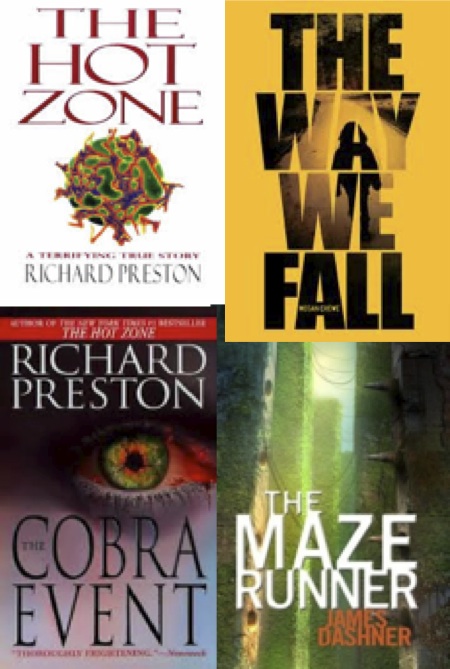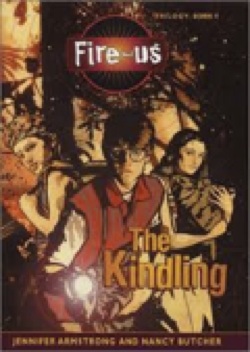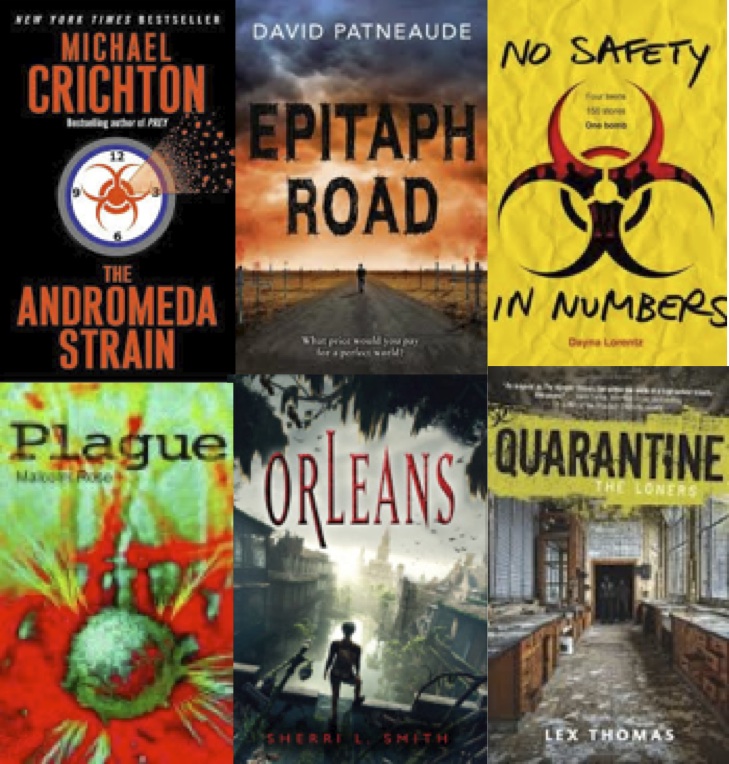by T. Gail Pritchard, PhD, College of Medicine, University of Arizona

This week, the books presented cover the “what if?” scenario: What if a naturally occurring virus swept through the world killing most of its inhabitants? What if scientists engineered a virus and it got out of control? What if a virus killed all the adults? What if one country unleashed a deadly virus on another? What if an alien virus appeared? All of these scenarios have been the subject of young adult novels. Here are a few to add to your reading list:
Preston, Richard. (1995). The Hot Zone: A Terrifying True Story. Anchor. ISBN-10: 0785775978, 448 pp.
When my oldest son was in his high school biology class, he came home one evening very excited about a required reading, The Hot Zone by Richard Preston. He insisted we go right out and buy a copy so he could get started on the reading. After a quick trip to our local bookseller, he settled in and began reading and reading and reading—I don’t think he stopped until he finished all 448 pages. Then I picked it up and was stunned to realize I had read a tiny little blurb in our local newspaper, years ago, about this very incident, but had paid little attention to it. Now I was reading the full-blown account of an Ebola outbreak in a research lab in Reston, VA and it was terrifying—and fascinating. This reading was part of the class’s study on viruses; and the teacher made a great call. She knew by reading this detailed account, she would hook the students into how a virus works, propelling them into further study; and that’s why I begin with this particular book this particular week—it’s one of the scariest books you will ever read and the fact that it is true, takes it to a whole new level….
 Armstrong, Jennifer. (2002). The Kindling (The Fire-Us Trilogy, Book 1). Harper Collins. ISBN-10: 0060080485. 224 pp.
Armstrong, Jennifer. (2002). The Kindling (The Fire-Us Trilogy, Book 1). Harper Collins. ISBN-10: 0060080485. 224 pp.
I read this trilogy in preparation for a Children’s Literature Assembly Masters’ Class at NCTE several years ago. At the conference, I sat at the table with the author and she was amazed at the zillion sticky notes I had stuck throughout the book filled with my questions and comments. She said she had never seen “evidence” of someone thinking so much about a book…. This first book in the trilogy made me think. It made me think about what happens in a world where a virus has killed all the adults and children are the remaining survivors; it made me think about how knowledge is stored, passed on to others, and it made me think how knowledge “evolves” in the telling and retelling. It made me think of the vulnerability of our fragile existence.
Dashner, James. (2009). The Maze Runner (The Maze Runner Series). Delacorte Press. ISBN-10: 0385737947. 384 pp.
The Maze Runner series has mixed reviews, mine included. I found the first novel in the series fascinating—a group of boys mysteriously plunked into a maze, with no memory of life prior to waking up in the maze, and new arrivals on a regular basis, and then the first girl arrives…. Ultimately, we find out this is part of a test, a very unethical one, to help scientists discover a cure for a manmade, airborne virus designed to control world population. As I progressed through the next two novels, I struggled with the premise of scientists putting children in danger and even killing them in painful ways in order to find a cure to save the world.
Preston, Richard. (1998). The Cobra Event. Ballantine Books. ISBN-10: 0345409973. 448 pp.
While I was at first hesitant to include this must read because it is not necessarily a “YA” novel, it is written by the same author as Hot Zone. This fictional account of biological warfare is equally thrilling (and gruesome) and like The Maze Runner, the intent is population control.
Crewe, Megan. (2012). The Way We Fall (The Fallen World Trilogy). Hyperion. ISBN-10: 1423146166. 320 pp.
Much like the very popular summer television series, Under the Dome, this novel centers on an island quarantined because of a deadly influenza virus picking off the island’s inhabitants. As the virus increases, supplies dwindle, and the town erupts into chaos. In an interview with Book Smugglers, Crewe notes, “I didn’t realize before I did my research just how elusive many viruses are. They can emerge seemingly out of nowhere, and with some of the most deadly ones (Ebola, for example), scientists still haven’t determined a definite source, even after decades of trying. I think that’s one of the most frightening things about viruses–that it’s impossible to predict when some new lethal strain might suddenly jump to human beings.”
There are a plethora of novels about pandemics, epidemics, and outbreaks—of late, quite a few lead to life as a zombie. However, as you read through these books and those listed below, I hope you will also consider those epidemics that are not thrilling, but are serious commentaries on life and society. It is those books that will conclude this month’s topic, next week.
Additional Reads:
 Crichton, M. The Andromeda Strain
Crichton, M. The Andromeda Strain
Lorentz, D. (2012). No Safety in Numbers.
Pateneaude, D. Epitaph Road
Rose, M. Plague
Smith, S. L. Orleans
Thomas, L. Quarantine—The Loners
Journey through Worlds of Words during our open reading hours: Monday-Friday, 9 a.m. to 5 p.m. and Saturday, 9 a.m. to 1 p.m. To view our complete offerings of WOW Currents, please visit archival stream.
- Themes: T. Gail Pritchard
- Descriptors: Books & Resources, WOW Currents
